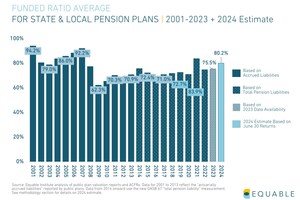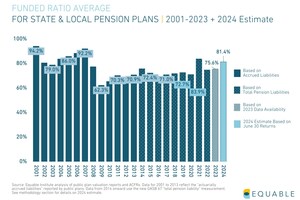Report finds funding shortfall to grow to 1.4 trillion in 2022, erasing nearly half of the gains from 2021's record investment returns; three-year funding trend remains net positive.
NEW YORK, July 20, 2022 /PRNewswire/ -- State and municipal retirement systems are on track to lose nearly half of 2021's once-in-a-century investment returns in 2022, according to Equable Institute's annual State of Pensions report. Following a year of record investment gains and economic growth, unfunded liabilities dipped below $1 trillion in 2021, bringing the aggregate funded ratio to 84.8%, the analysis finds. However, Equable estimates that the aggregate funded ratio for U.S. public pension funds will decline to 77.9% in 2022 and unfunded liabilities will increase to $1.4 trillion — the largest single-year decline in funded ratio since the Great Recession.
In the first half of 2022, U.S. public pension funds have weathered a bear market, geopolitical conflict, and record inflation. Despite these difficult economic headwinds, Equable finds that there has been a net positive funding trend over the last three years: even with losses this year, the funded status at the end of 2022 will be better than it was at the end of 2019.
"Public pension funded ratios would look a lot worse this year if there hadn't been a wave of states lowering investment assumptions, ramping up contribution rates, and adopting risk-mitigation tools over the past decade," said Equable executive director Anthony Randazzo. "In an era of substantial financial market volatility, state and local pension funds need policies that allow for automatic contribution rate and benefit adjustments to stabilize retirement systems when there are negative shocks like we've seen this year. Public pension funds are not going to simply invest their way back to fiscal health and resilience."
The report, State of Pensions 2022, analyzes trends in public pension funding, investments, contributions, cash flows, and benefits for 228 of the largest statewide and municipal retirement systems in all 50 states (e.g., retirement plans with at least $1 billion in accrued liabilities). This edition of State of Pensions marks a notable expansion in Equable's data set with the addition of 61 municipal plans, significantly widening the scope and accuracy of the analysis. The report also offers a spotlight on the wide range of inflation protection benefits offered — or not offered — by state and local pension plans nationwide.
Looking back on a year of unprecedented volatility, the analysis concludes that the state of pensions is fragile. Specifically, the report finds:
- Preliminary 2022 investment returns for state and local plans are -10.4% on average, through June 30, 2022. All public pension plans are projected to underperform their assumed return targets. The net result is the largest single-year decline in assets since 2009.
- Asset allocations continue to shift towards riskier alternative investments. The share of assets allocated to hedge fund managers and private equity strategies has grown to 14.9%, up from 8% of allocations in 2008.
- States have tempered their investment assumptions significantly. The average assumed rate of return is now 6.9%, below the 7% mark for the first time in modern history. There are now 83 state and local plans assuming investment returns below 7%, as of June 2022. In 2020, just 65 plans expected returns of 7% or less.
- States have meaningfully improved their funding practices and policies. In 2021, 99.8% of required contributions were made by state and municipal governments, the highest level since 2001. More than a dozen states also used budget surpluses and rainy-day funds to make supplemental payments this year or approved them in 2022-23 budgets, totaling more than $12 billion.
- Since 2019, Equable finds that only 10 states have experienced a decline in funded ratio: Minnesota, Oregon, Idaho, Nebraska, Montana, North Carolina, Vermont, Arkansas, New Hampshire, and Nevada. However, even with 2021's investment returns, only 42% of public retirement plans would be considered resilient.
- The cost of public retirement benefits have increased for members and employers. Public sector workers who are enrolled in Social Security paid 39.2% more during the 2022 fiscal year than they did in 2001. Those who do not participate in Social Security paid 13.8% more. Employer contribution rates have more than tripled, growing from 9.02% of payroll in 2001, to 30.4% of payroll in 2022.
- Public retirees may be more exposed to inflation that many assume, given the limited cost-of-living adjustment (COLA) provisions that are available across the country. 168 plans do not offer or guarantee retirees a COLA. For plans that do offer inflation protection, the average COLA is 1.58% in 2022, which is significantly less than the estimated 8.6% rate of inflation (CPI as of May 2022) nationally.
For a deeper look into The State of Pensions 2022, visit http://www.equable.org/StateofPensions2022 to access additional downloads and interactive data visualizations. Additional media tools including figures, fact sheets and raw data can be found here.
Equable is a bipartisan non-profit that works with public retirement system stakeholders to solve complex pension funding challenges with data-driven solutions. We exist to support public sector workers in understanding how their retirement systems can be improved, and to help state and local governments find ways to both fix threats to municipal finance stability and ensure the retirement security of all public servants.
Equable.org | Twitter: @EquableInst | Facebook: @EquableInstitute | Instagram: @EquableInst
SOURCE Equable Institute

WANT YOUR COMPANY'S NEWS FEATURED ON PRNEWSWIRE.COM?
Newsrooms &
Influencers
Digital Media
Outlets
Journalists
Opted In





Share this article